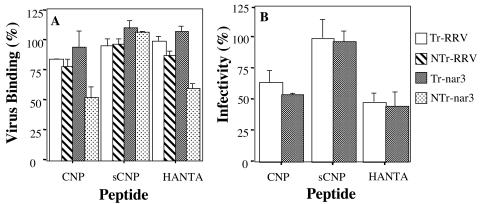FIG. 5.
Effect of the synthetic peptides on the binding and infectivity of RRV and nar3 rotaviruses. (A) MA104 cells in 48-well plates were preincubated with 4 mg of each peptide/ml for 1 h at 4°C, the excess of peptide was removed, and 500 ng of Tr- or NTr-RRV and -nar3 viruses was then added, followed by incubation for 1 h at 4°C. The amount of bound virus was determined by an ELISA. The data are expressed as the percentage of the virus bound when the cells were preincubated with PBS as a control. The arithmetic means and standard deviations for two independent experiments performed in duplicate are shown. (B) MA104 cells grown in 96-well plates were preincubated for 1 h at 37°C with 4 mg of peptides CNP, sCNP, or HANTA/ml; the excess peptide was removed, and 2,000 FFU per well of either RRV or nar3 virus were then added and adsorbed for 1 h at 37°C. The excess inoculum was removed, and the infection was allowed to proceed for 14 h at 37°C. Finally, the cells were fixed and immunostained as described in Materials and Methods. The data are expressed as the percentage of virus infectivity obtained when the cells were preincubated with MEM as a control. The average numbers of foci representing 100% infectivity were 157 and 207 for RRV and nar3, respectively. The arithmetic means and standard deviations of three independent experiments performed in duplicate are shown.

